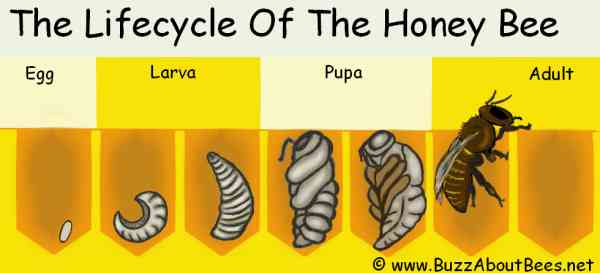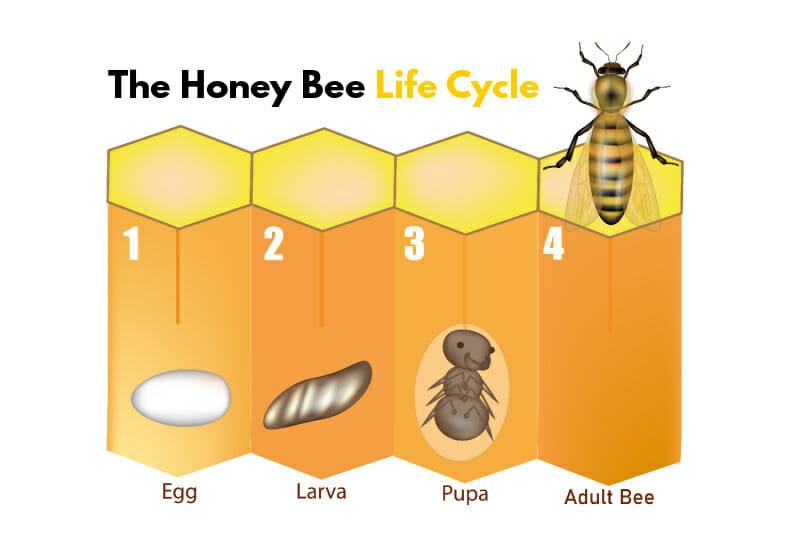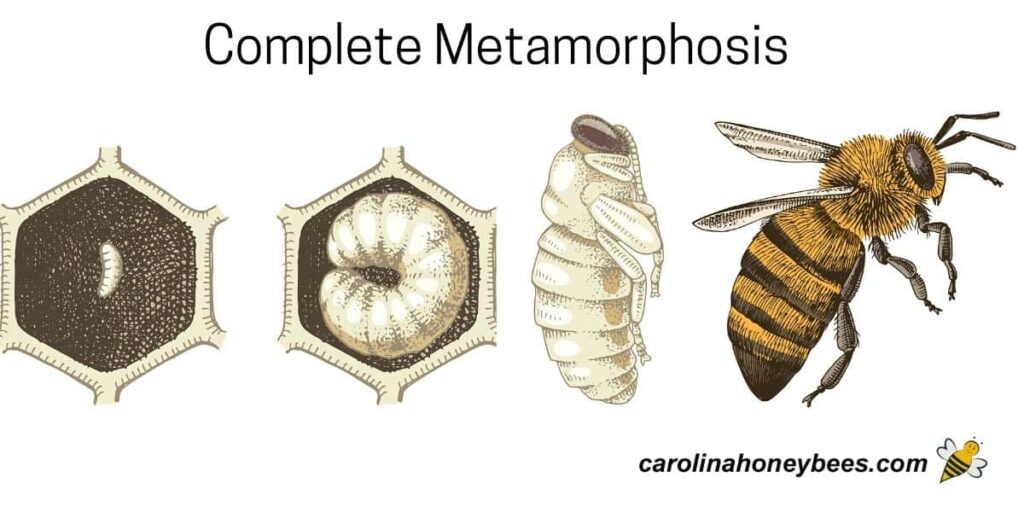
Have you ever wondered about the fascinating journey of a honeybee? From buzzing around flowers, collecting nectar, to producing honey, bees go through an incredible transformation. One pivotal stage in their life cycle is the pupa pause, a crucial phase that occurs between the larvae and adult bee stages. During this time, the bee undergoes significant changes within its cocoon, preparing itself for the world outside. Join us as we explore the wonders of the pupa pause and gain a deeper understanding of the remarkable life of a bee.

Overview
What is the pupa pause?
The pupa pause is a crucial stage in the life cycle of a bee. It is the period during which the larva transforms into an adult bee. This phase is characterized by significant physical changes and the development of the bee’s body structure. The pupa pause is a critical stage in the bee’s life cycle as it is the time when the bee undergoes metamorphosis and prepares itself to join the outside world as an adult bee.
Importance of the pupa pause
The pupa pause plays a vital role in the life cycle of a bee. It is during this stage that the larva undergoes a dramatic transformation to become an adult bee. The pupa pause allows the bee to develop and form its body structure, enabling it to carry out the necessary functions for survival, such as foraging for food, reproduction, and pollination. This phase is essential for the bee to transition from a helpless larva to a fully functional adult bee, making it a crucial and significant phase in the bee’s life.
Life Cycle of a Bee
Egg stage
The life cycle of a bee begins with the egg stage. A queen bee lays an egg, which is approximately the size of a grain of rice, in a wax cell within the honeycomb. The egg stage typically lasts for about three days, during which the egg is cared for and nourished by the worker bees.
Larva stage
From the egg stage, the bee larvae emerge. The larvae are small, grub-like creatures that lack developed limbs and eyes. During this stage, the young larvae are fed with a special substance called royal jelly, which is produced by the worker bees. The larva stage lasts for about six days, during which the larvae grow and develop rapidly.
Pupa stage
After the larva stage, the pupa stage begins. This is the stage when the dramatic transformation from a larva to an adult bee takes place. The pupa is enclosed within a cocoon-like structure, known as a puparium, which provides a protective environment for the developing bee. During this stage, the body of the pupa undergoes significant changes, including the formation of wings, legs, and other body parts.
Adult stage
Finally, the adult stage is reached. The fully developed bee emerges from the pupa, breaking free from the puparium. The adult bee has the ability to fly, forage for nectar and pollen, reproduce, and carry out all the functions necessary for the survival of the colony. The duration of the entire life cycle of a bee, from egg to adult, varies depending on the species and environmental conditions.
The Pupa Stage
Transformation of the larva
The pupa stage is an essential period in the life of a bee as it marks the transformation from a larva to an adult bee. During this stage, the larva undergoes a complete metamorphosis, which involves the reorganization of its internal structures and the development of adult characteristics. This transformation is driven by hormonal changes within the pupa’s body, directing the growth and formation of various body parts.
Formation of the pupa
Before entering the pupa stage, the larva prepares itself by spinning a silken cocoon around its body. This cocoon provides protection and support during the pupa stage. Once inside the cocoon, the larva metabolically transforms into a pupa, and various body parts, such as wings, limbs, and antennae, begin to form within the pupal exoskeleton.
Physical changes during pupation
During pupation, significant physical changes occur within the pupa. The body of the pupa becomes more elongated, and the wings and legs develop and differentiate. The exoskeleton of the pupa hardens, providing structural integrity and protection. The internal organs undergo intricate development, including the formation of reproductive organs and other vital structures necessary for the adult bee’s functioning. These physical changes are critical for the pupa to transition into a fully functional adult bee.
Duration of the Pupa Stage
Variances in pupa stage duration
The duration of the pupa stage can vary depending on various factors, including the bee species and the environmental conditions. On average, the pupa stage lasts for around 7 to 14 days, but certain bee species may have shorter or longer durations. For example, honey bees typically have a pupa stage duration of 12 to 14 days, while bumblebees may have a pupa stage lasting for only 7 to 10 days. The specific duration of the pupa stage is genetically determined and is essential for the bee’s overall development.
Factors affecting pupation duration
Several factors can influence the duration of the pupa stage. One of the primary factors is temperature. Warmer temperatures generally lead to a shorter pupa stage duration, while cooler temperatures can prolong the pupa stage. Additionally, the availability of food and the overall health of the larva can also impact the pupation duration. Adequate nutrition during the larva stage is crucial for the pupa to develop properly and efficiently transition into an adult bee.

The Purpose of Pupation
Metamorphosis and development
The pupa stage serves the critical purpose of metamorphosis and development. During this stage, the larva transforms into an adult bee through a series of complex physiological processes. The pupa stage allows for the reorganization and differentiation of body tissues and the formation of adult structures, such as wings, legs, and sensory organs. Without pupation, the bee would not be able to develop fully and carry out its essential functions as an adult bee.
Building adult body structure
One of the primary purposes of the pupa stage is the building of the adult body structure. During this stage, the bee’s body undergoes intricate development, with various body parts forming and maturing. The wings, which are essential for flight, grow and differentiate. The legs, antennae, and other sensory organs also develop, allowing the bee to navigate its environment and carry out crucial tasks such as foraging for food and communicating with other bees. The pupa stage lays the foundation for the bee’s adult body structure, enabling it to thrive in its surroundings.
Behavior during Pupation
Immobility of the pupa
During the pupa stage, the bee exhibits a remarkable behavior of immobility. Unlike the larva stage, during which the bee larvae are actively fed and move within the honeycomb, the pupa remains completely still. This immobility is a result of physiological changes occurring within the pupa’s body. The pupa uses the energy stored from its larval stage to fuel the metamorphosis process, minimizing physical movements.
Protection mechanisms
Even though the pupa remains immobile, it possesses certain protection mechanisms to ensure its safety during this vulnerable stage. The puparium, or pupal exoskeleton, provides a physical barrier against external threats. It shields the developing bee from environmental hazards and potential predators. Additionally, worker bees within the hive may also play a role in guarding and protecting the pupae, ensuring their continued development under the watchful care of the colony.

Nutritional Requirements
The importance of stored food
The bee larvae store significant amounts of food within their bodies during the larval stage, which they utilize during the pupa stage. This stored food, in the form of stored fat and other nutrients, plays a crucial role in providing the necessary energy for the pupa to undergo metamorphosis. It fuels the physical changes occurring within the pupa’s body and ensures that the pupa has sufficient resources for its development into an adult bee.
Energy allocation during pupation
During pupation, the stored food within the pupa’s body is gradually consumed to provide the necessary energy for the pupal development. The energy allocation process is carefully regulated by the pupa’s physiology and ensures that the resources are distributed efficiently to support the growth and differentiation of various body parts. The allocation of energy during pupation is a critical process that contributes to the successful transition of the bee from a pupa to an adult bee.
Environmental Factors
Temperature and its influence
Temperature plays a significant role in the pupation process. Optimal temperatures are necessary for the pupa to develop correctly and efficiently. Warmer temperatures generally accelerate the pupa’s development, whereas cooler temperatures can prolong the pupa stage. The temperature requirements vary depending on the bee species. Bee colonies utilize their collective efforts to control the temperature within the hive, ensuring that the pupae are exposed to suitable temperature conditions that facilitate their development.
Humidity and ventilation
Humidity and ventilation also impact the pupation process. Adequate humidity levels are necessary to maintain proper moisture within the puparium, which is crucial for the development of the pupa. Improper humidity levels can lead to dehydration or excessive moisture, which can hinder the pupa’s development. Furthermore, proper ventilation within the hive ensures the exchange of gases and prevents the accumulation of harmful substances, creating an optimal environment for the pupation process.

Predators and Adversities
Challenges during the pupa stage
The pupa stage is a vulnerable period for the bee as it undergoes significant physical changes within the protective puparium. However, various challenges and adversities can threaten the pupae’s development. Environmental factors such as extreme temperatures, inadequate nutrition, or unfavorable humidity levels can negatively impact the pupa’s health and development. Additionally, diseases and parasites can also pose threats to the pupae, leading to deformities or death.
Predators targeting pupae
The pupa stage is also a time when predators may target the vulnerable bees. Certain insect predators, such as beetles and ants, may attempt to gain access to the pupal exoskeleton and prey on the developing bee inside. Furthermore, some bee species may face challenges from specialized predators, such as mites or wasps, which have evolved to exploit the pupae as a food source. Bee colonies employ various protective measures, such as guarding the hive and implementing hygienic behaviors, to defend against these predators and ensure the successful development of the pupae.
Signs of Developing Pupae
External indications
There are certain external indications that can suggest the presence of developing pupae within the hive. These signs include partially capped cells within the honeycomb, indicating that the larvae have entered the pupa stage. The capped cells serve as protective barriers, preventing disturbances or contamination that could affect the pupae’s development. The appearance of these capped cells is a promising sign that the colony is progressing and preparing for the emergence of adult bees.
Internal changes
Internal changes within the honeycomb also provide clues regarding the presence of developing pupae. The worker bees diligently maintain the hive, and careful inspections may reveal the presence of pupae within the cells. The workers may be observed attending to the capped cells, caring for and nourishing the developing pupae. These internal changes indicate that the colony is actively supporting the growth and development of the pupae, ensuring the continuation of the bee population.
In conclusion, the pupa pause is a crucial phase in a bee’s life. It marks the remarkable transformation from a larva to an adult bee, allowing for the development of the bee’s body structure and the completion of metamorphosis. The pupa stage is a time of immobility and protection, during which the pupa utilizes stored food to fuel its development. Environmental factors, such as temperature and humidity, play a significant role in the success of pupation. The pupae face various challenges, including predators and adversities, but the colony’s collective efforts and protective mechanisms ensure their development. Recognizing the signs of developing pupae within the hive provides insight into the progress and growth of the colony. The pupa pause is undeniably a crucial and fascinating phase in the life of a bee, enabling the transition from a helpless larva to a fully functional adult bee.
